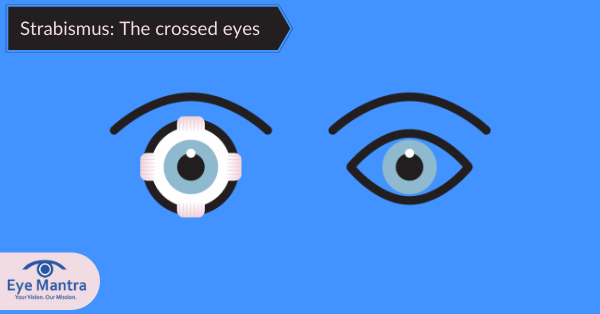Contents
What Is Strabismus Or Cross Eyes?
Affecting an estimated two per cent of youngsters globally, Strabismus or Esotropia, more commonly referred to as cross-eyes, is an eye fixed condition most ordinarily occurring in infants. The condition causes a misalignment of the eyes — wherein one eye looks straight ahead and therefore the other eye looks upward, downward, to the left or right.
Causes of Strabismus Or Cross Eyes?
This disease occurs when the six muscles around your eye don’t function in perfect coordination. This is often caused by:
• Muscle dysfunction
• Problems within the brain
• Trauma round the region of the attention, like getting hit within the face
• Infections Genetics may play some role, as parents with strabismus have a better chance of getting children with an equivalent condition.
Symptoms OF Strabismus
This condition can affect our vision and cause discomfort for several. a number of the common symptoms include:
• Headaches
• Excessive squinting
• In some case, sufferers develop a lazy eye
Besides vision-related problems, dealing with strabismus can cause problems with low self-esteem. Routine exams by the optometrist can detect strabismus early and supply assistance in determining the simplest options for treatment.
What Happens To Eyes With Strabismus?
For people with strabismus, the eyes aren’t ready to specialize in one point or object. Therefore the brain cannot combine the 2 images produced by the eyes to make a traditional 3-dimensional image.
Instead of trying to process two different images, the brain ignores the image sent from the more misaligned eye. This is often a drag because the eyes are meant to figure together for a more accurate vision. This is often why people affected by strabismus often have issues with depth perception and coordination problems.
Treatment of Strabismus
Strabismus treatment aims to enhance eye alignment in order that your vision is improved. Treatment options are varied, but often involve eyeglasses, eye exercises, and ocular muscle surgery.
Though surgery is usually a standard treatment, vision therapy that has corrective glasses and consistent eye exercises has been shown to achieve success in correcting cross-eyes. To find out more about strabismus and if surgery is important, visit your nearest optician.
Expected Duration
The intermittent strabismus seen in infants is related to normal development and typically goes away before 3 months aged. Other sorts of strabismus don’t get away unless treated.
Prevention of Strabismus
Strabismus can’t be prevented. However, complications of strabismus are often prevented if the matter is detected early and treated properly. Children should be monitored closely during infancy and therefore the preschool years to detect potential eye problems, particularly if a relative has strabismus.
The American Association for Pediatric Ophthalmology and Strabismus, the American Academy of Pediatrics, and therefore the American Academy of Family Physicians recommend that at a minimum all children be screened for eye health before age 6 months, regularly during each check-up, and again between 3 and 5 years aged by a pediatrician, family practitioner or ophthalmologist.
Routine vision screening for young children includes testing for strabismus, usually using the sunshine reflex for infants, and canopy testing for preschool-age children. Crescents of sunshine reflected off the eyes can indicate strabismus or other eye problems including nearsightedness, farsightedness and cataracts.
Treatment
The primary goal of treatment is to preserve or restore the maximum amount of visual function as possible. Treatments vary, counting on the sort and explanation for strabismus. Glasses are wont to correct vision within the weaker eye. A patch is often worn over the well-liked eye to force the kid to use the weaker or suppressed eye. Eye drops are wont to temporarily blur the vision of the well-liked eye for an equivalent purpose. Exercises could also be prescribed to strengthen specific eye muscles. Forcing a toddler to use the weaker eye can improve sight by reinforcing the connection between the attention and therefore the brain.
The surgery for tightening or/and loosen specific eye muscles usually is required to realign the eyes. This short operation typically is completed under general anaesthesia and should involve one or both eyes. Occasionally, the primary surgery doesn’t align the eyes completely and extra surgery is required.
When to call knowledgeable
You should ask your child’s health care professional as soon as possible a few any concerns about a child’s ability to ascertain or about the alignment of his or her eyes. A toddler who has constant strabismus at any age or intermittent strabismus that lasts beyond 3 months aged should be evaluated by a pediatric ophthalmologist.
An adult who develops diplopia or other signs of strabismus should contact his or her health care professional for further evaluation.
Conclusion
With early detection, accurate diagnosis and proper treatment, the outlook for youngsters with strabismus is superb. Treatment before age 6 years aged, and particularly before 2 years aged, gives the simplest results.
We also offer various services like Retina Surgery, Specs Removal, Lasik Surgery, Squint, Cataract Surgery, Glaucoma surgery, and much more.
Related Articles:
Best Tips for Eye Care in Pollution
Diet & Nutrition for healthy eyes
Computer Effect on Eyes: Causes, Symptoms & Tips for Relief in Delhi



